| And so onward and westward another couple of hundred miles to
Havre. This is a big railway town (not much else) with repair shops and
engine sheds etc. The road (US2) parallels the railway for most of its way
across the western US and there was a constant procession of freight trains
usually headed by three BNSF engines but in a variety of liveries. The
latter two of these were CSX (another company) | 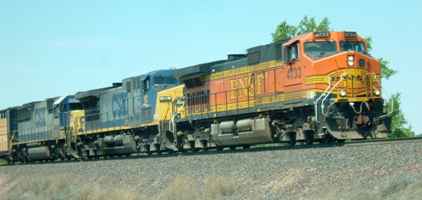 . . |
 | The bulk of the
freight here seems to be in containers, often double stacked, mostly with
Chinese markings demonstrating just how much Chinese goods are moving into
the US market. But there were also number of trailers on flatbeds and a
selection of other types.. |
| Most trains had three engines but this one had five. We just
thought it was colourful. |  |
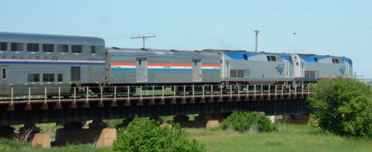 | We also caught a
glimpse of an extremely rare Amtrak passenger service which runs daily in
each direction. We actually saw both ways since they pass at Malta or Zurich
(on the way to Havre). We also reckon that it can't be a quick service
because the westbound train must have been waiting an hour for the
eastbound. Note the double deck coaches. |
| Just before we got to Havre, at Chinook, we came across an
excellent little Pioneer museum which had a short presentation on Chief
Joseph and the Nez Perce Indians. It made very sad reading and these three
photographs of him showed a man of great stature. The last one was of him in
1903 just before he died. | 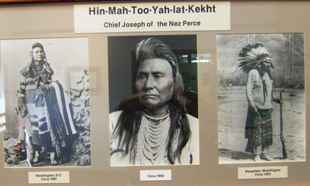 |
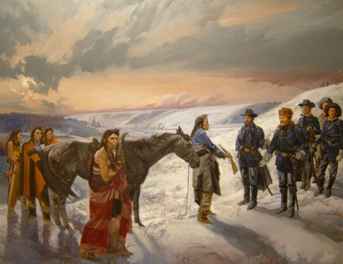 | There was this
poignant painting of the surrender when he finally submitted just 40 miles
from the Canadian border and safety. He was never allowed to return to his
homeland. When you realize that this was Christmas and the weather up here
is pretty bleak, you can't imagine the conditions for the women and children
many of whom were killed by the soldiers.. |
| The inhospitable lands in the far north of the US are home to the
reservations of many of the native tribes. The living conditions are fairly
dire in all of them. Most of the income seems to come from casinos and
gambling. Many of the Indian-run museums are poor in both the quality and
quantity of the exhibits, and any interest and pride in showing such things
to the many tourists is often completely absent. The contrast with the
Pioneer museums on the service front is most marked. The Pioneer museums
are generally full of quaint homesteader items such as we would find in
Sheffield's Kelham Island or any industrial museum. However you have to
remember that this is old to them, if not to us.
Thus the items of greatest interest to us are the native made clothing.
They have some beautiful beading and quillwork on display. | 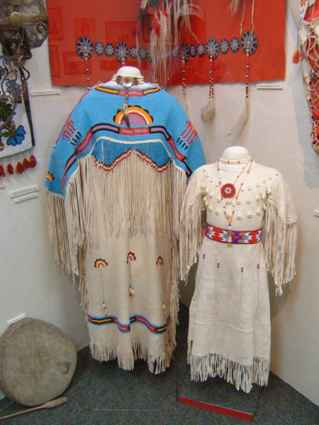 |
 | Eventually,
after 1000 miles of plains, you get to the Rocky Mountains, which just seem
to rear up out of nowhere. You are just suddenly aware that the shapes you
can see on the horizon are not clouds, but mountains. |
| They still take forever to reach the state of being recognisable
mountains, and the road still seems to go on. At this point we are still
some 20 miles away and unaware that the flat plain has been steadily rising
for the last 50 miles and we are now 2000ft higher than we were. |  |
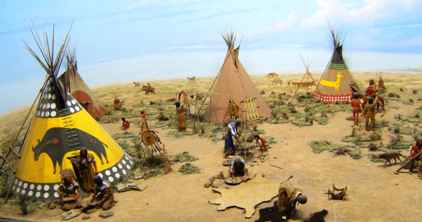 | But before we get to
the mountains, we had a brief pause at the Museum of the Plains Indian
at Browning at the foot of the Rockies and the centre of the Blackfeet
reservation. This was quite good as Indian museums go, with a couple of well
set out dioramas showing daily life. |
| There was also an unusual depiction of the Sun Dance ritual which
was important to a number of tribes and took place at annual gatherings. | 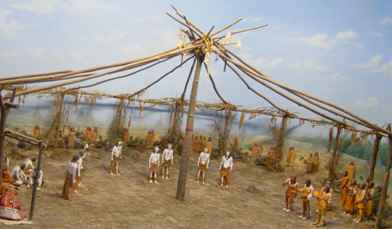 |
 | In amongst the
displays there is some interesting information like this chart of migrations
showing how one tribe supplanted another in an area over time. It also shows
which tribes were related by language and which were completely separate. |
|